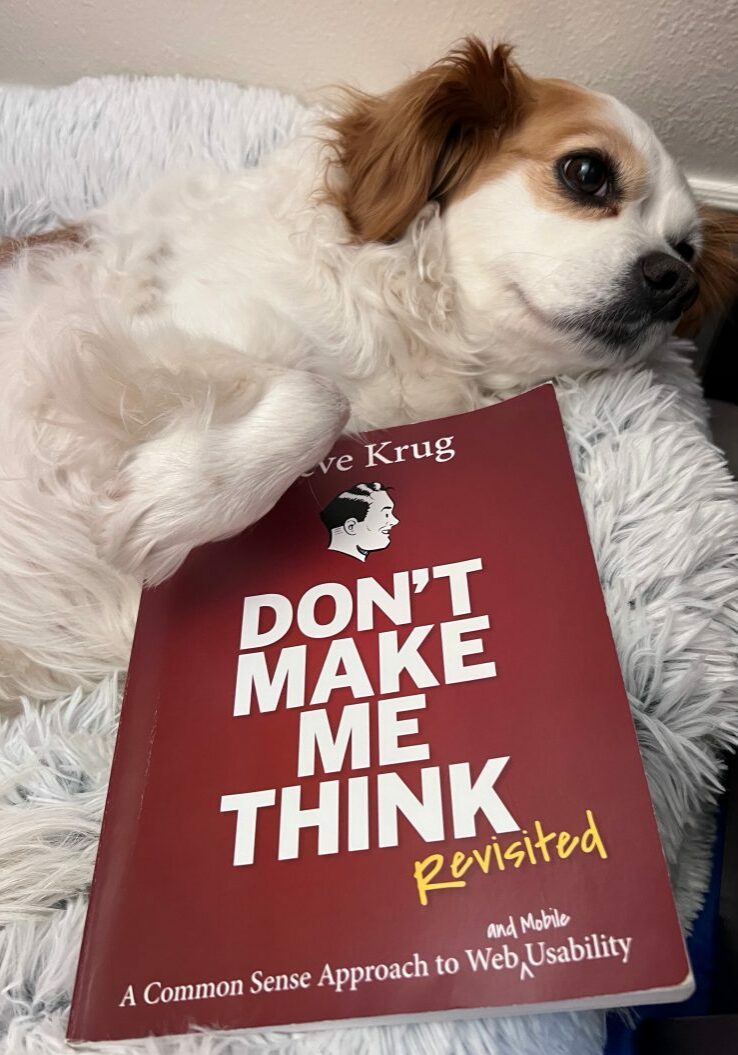Don’t Make Me Think Revisited by Steve Krug
One of my biggest frustrations, when I go to a website is when they make me overthink. Especially when it’s a site I want to buy something, and figuring out how to do that can be downright impossible. So I gave up and left.
Why does that happen? What’s up with businesses – don’t they know how to create a useful website?
Well, from my experience, I’d say not all sites are created equal. Part of the issue could be that there are so many web platforms to choose from. And no one likes to stare at a blank page – what do you put on those pages anyway?!
When creating a website, the biggest issue is the site is NOT FOR YOU! It’s for your dream clients/customers. That’s the worst offense I’ve seen in my many years of working with businesses and helping them create high-converting sites and online dream client experiences.
After a few years of owning my business, I worked with a web dev company. That was a true eye-opener. One required reading was the book – Don’t Make Me Think, Revisited by Steve Krug.
Even though this book was published in 2014, there’s still so much terrific information in here. The author Steve Krug spent ten years as a usability consultant helping his clients make their products easier to use.
His book sold a ton of copies, and it’s the go-to book for web design.
A Book Summary to Inspire You To Read It!
Quick Summary: “Don’t Make Me Think” is a valuable resource in web design, creating online navigation and usability for online courses and products. It offers a concise and practical guide to creating user-friendly websites. I love Krug’s approach because it’s straightforward and easy to understand. Plus, the book is filled with helpful tips and insights that can be applied to any web design project.
The in provides a practical and straightforward approach to web design. It aims to help you create user-friendly websites by simplifying your design and making it more intuitive for users. The book covers the basics of web design and offers insights and guidelines on creating websites that are easy to use, understand, and navigate.
Who Ought to Read this Book: I’m not a web developer or designer. I’m a marketer that works with many entrepreneurs to help them optimize their websites and online presence. This book was tremendous in giving me another perspective to look at a website from the user, not the entrepreneur who’s creating it for them – that approach doesn’t work. I’d recommend this for web developers, designers, marketers, copywriters, and anyone whose prime business is working with websites, design, and copy.
Things You Will Discover:
Core principles for creating user-friendly websites:
Simplicity: Websites should be simple, straightforward, and easy to use. The design should not require users to think too much about how to use the site.
Self-explanatory: Websites should be self-explanatory and provide a clear and direct path to the information users are seeking.
Established conventions: Web design should follow established conventions so users feel comfortable and familiar with the site.
Usability testing: Web designers should constantly test their designs and make changes based on user feedback.
Accessibility: Websites should be accessible to all users, including those with disabilities.
Content-first approach: Content should be the primary focus of web design, with design elements supporting and enhancing the content.
Consistency: The design and layout of a website should be consistent throughout the site, so users know what to expect and can navigate easily.
These principles aim to help web designers create websites that are easy to use, understand, and navigate, so users can find what they’re looking for and achieve their goals without frustration.
Krug emphasizes the importance of designing effective home pages for websites. The home page is often the first point of contact that users have with a website, and it needs to convey a clear message about what the site is, what it offers, and how to navigate it.
A good home page should be simple, clear, and intuitive, with a clear information hierarchy that guides users to the most important content. He recommends using clear and concise language and avoiding jargon and technical terms that may confuse or alienate users.
In addition, Krug suggests that home pages should be designed with scanning in mind, as most users tend to scan rather than read web pages.
This means using headings, subheadings, and bullet points to break up text and make it easier to digest.
He also recommends using visual cues such as images, icons, and colors to highlight important information and create visual interest.
Your Home Page Needs to Answer These Four Questions For New Vistors: These need to be answered in the first 3 – 7 seconds easily with very little effort.
- What is this?
- What do they have here?
- What can I do here?
- Why should I be here and not somewhere else?
Krug’s Big Bang Theory of Web Design:
It’s a philosophy that emphasizes the importance of starting with a simple, usable design and gradually adding complexity over time as needed. Start small and focus on usability rather than trying to create a fully-featured website from the outset. By prioritizing simplicity and user-centered design, designers can create more effective, more satisfying, and ultimately more successful websites.
INSPIRING BOOK QUOTES:
Make Sure It Works:
“Usability really just means making sure that something works well: that a person of average (or even below average) ability and experience can use the thing – whether it’s a website, a fighter jet, or a revolving door – for its intended purpose without getting hopelessly frustrated.”
They May Not Like Your Site:
“The fact that people are willing to work hard at using your site doesn’t mean that they like it.”
Less Copy is More:
“Get rid of half the words on each page, then get rid of half of what’s left.”
It’s About the Scanners:
“Design for scanning, not reading.”
Testing is King:
“If you want a great site, you’ve got to test. After you’ve worked on a site for even a few weeks, it becomes difficult to see it freshly. You know too much. Conducting tests is like taking a cold shower: It wakes you up to what’s really happening.”
Design For Words:
“Designing for the Web is primarily about the words because that’s how people use it.”
No Need For Instructions:
“The design of everyday things should not require instruction.”
It’s About Your Website Experience:
“You’re not designing “site architecture,” you’re designing the wayfinding experience.”
It’s Not About You:
“Don’t tell me what you like, tell me what works.”
Design For Your Web Vistors Experience:
“Usability is not everything. If usability engineers designed a nightclub, it would be clean, quiet, and empty. Instead, they should design a nightclub that’s dark and noisy and full of poorly designed furniture, and they should make sure that there are few exits, the toilets are difficult to find, and the waiters are surly. That’s because good designers understand that their job is to create an experience.”
When It Comes to Clicking:
“Users don’t mind a lot of clicks as long as each click is painless and they have continued confidence that they’re on the right track, following what’s often called the “scent of information.”
About the Author: Steve Krug
Steve Krug (pronounced “kroog”) is best known as the author of Don’t Make Me Think: A Common Sense Approach to Web Usability, now in its third edition with over 600,000 copies in print.
Its younger sibling is the usability testing handbook Rocket Surgery Made Easy: The Do-It-Yourself Guide to Finding and Fixing Usability Problems.
The books were based on the 25+ years he spent as a usability consultant for a wide variety of clients like Apple, Bloomberg.com, Lexus.com, NPR, and the International Monetary Fund.
His consulting firm, Advanced Common Sense (“just me and a few well-placed mirrors”), is based in Chestnut Hill, MA.
Steve currently spends most of his time either a) writing or b) watching old movies on tv (when he really should be writing).
Author’s Website:
Get Your Copy:
Don’t Make Me Think, Revisited by Steve Krug https://amzn.to/3lJZ5rC
Other Books You Might Be Interested In:
Rocket Surgery Made Easy by Steve Krug – This is another book by Krug that provides practical advice and guidance on how to conduct usability testing.
Designing for Interaction by Dan Saffer – This book covers a broad range of design principles and techniques for creating effective interactive experiences.
The Elements of User Experience by Jesse James Garrett – This book provides a comprehensive overview of the different components that make up a successful user experience, from strategy to design to content.
Soulfully Yours,
Previous Book Review

Don’t Make Me Think Revisited by Steve Krug

Hey there, I'm Shannon! Being a voracious reader and passionate about learning, I started this site in the hopes of sharing my thoughts and my love of inspiring nonfiction books that can help you. It's kind of like Buddha meets business. I truly hope you enjoy!
Subscribe to New Posts
© 2023 BooksYouGottaRead.com / SoulfulMarketing.com.
Powered by McCaffery Communications, LLC. All Rights Reserved.

